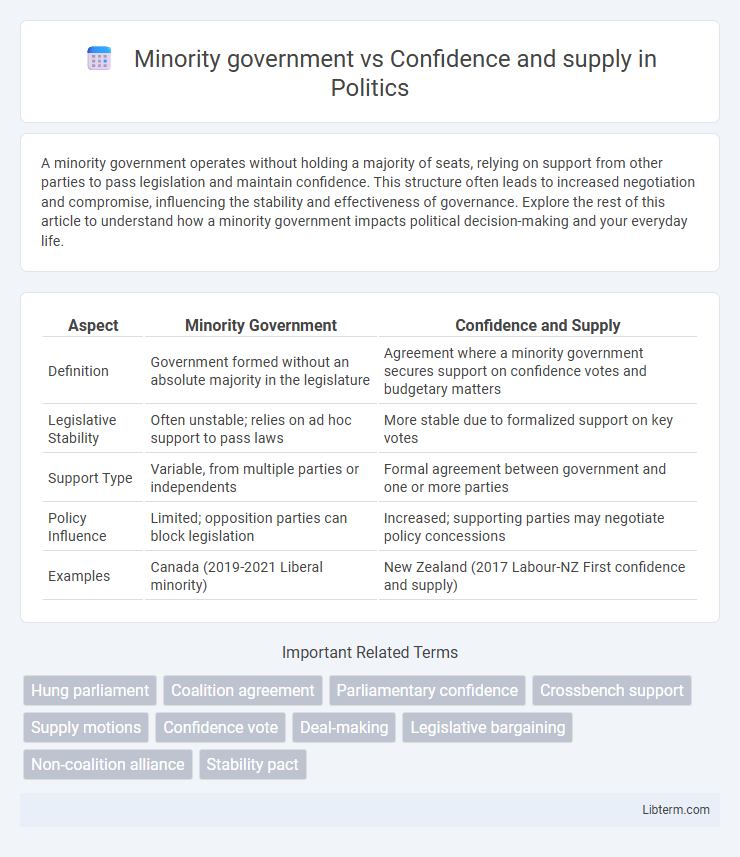A minority government operates without holding a majority of seats, relying on support from other parties to pass legislation and maintain confidence. This structure often leads to increased negotiation and compromise, influencing the stability and effectiveness of governance. Explore the rest of this article to understand how a minority government impacts political decision-making and your everyday life.
Table of Comparison
| Aspect | Minority Government | Confidence and Supply |
|---|---|---|
| Definition | Government formed without an absolute majority in the legislature | Agreement where a minority government secures support on confidence votes and budgetary matters |
| Legislative Stability | Often unstable; relies on ad hoc support to pass laws | More stable due to formalized support on key votes |
| Support Type | Variable, from multiple parties or independents | Formal agreement between government and one or more parties |
| Policy Influence | Limited; opposition parties can block legislation | Increased; supporting parties may negotiate policy concessions |
| Examples | Canada (2019-2021 Liberal minority) | New Zealand (2017 Labour-NZ First confidence and supply) |
Introduction to Parliamentary Government Structures
Minority government occurs when a ruling party holds fewer seats than the combined opposition in a parliamentary system, requiring negotiation and cooperation to pass legislation. Confidence and supply arrangements involve formal agreements between the minority government and other parties to secure support on key votes like budgets and confidence motions, ensuring stability without a formal coalition. Both structures reflect strategies within parliamentary governance to maintain functioning administrations despite the absence of an outright majority.
Defining Minority Government
A minority government occurs when the ruling party holds fewer seats than the combined opposition in the legislature, lacking an absolute majority. This situation forces the governing party to seek support from other parties to pass legislation and maintain stability. Unlike confidence and supply agreements, which are formal arrangements for support, a minority government operates without guaranteed backing from other parties.
Understanding Confidence and Supply Agreements
Confidence and supply agreements are arrangements where smaller parties or independents support a minority government in key votes, such as budgets and confidence motions, without formally joining a coalition. These agreements ensure government stability by providing agreed-upon support while allowing supporting parties to maintain independence on other legislative matters. Confidence and supply differ from minority governments that lack explicit agreements, as they secure a committed backing pivotal for sustaining power and passing critical legislation.
Key Differences: Minority Government vs Confidence and Supply
A minority government occurs when the ruling party lacks an overall majority in the legislature, relying on support from other parties to pass legislation and maintain power. Confidence and supply agreements involve specific arrangements where smaller parties or independents agree to support the government on key votes of confidence and budgetary matters without formally joining a coalition. The key difference lies in the formal structure: minority governments govern without a stable majority, while confidence and supply agreements provide targeted support ensuring government stability on crucial votes.
Historical Examples of Minority Governments
Historical examples of minority governments include Canada's 2004 Liberal government under Paul Martin, which relied on confidence and supply agreements with the New Democratic Party to remain in power. In the UK, Theresa May's 2017 Conservative government operated as a minority administration supported by a confidence and supply deal with the Democratic Unionist Party. Australia's 2010 Gillard government is another case, governing as a minority with informal support agreements that ensured confidence and supply in the House of Representatives.
Case Studies: Notable Confidence and Supply Arrangements
Notable confidence and supply arrangements such as the 2017 New Zealand Labour-NZ First coalition and the 2010 UK Conservative-DUP agreement illustrate how minority governments can maintain stability without full coalitions. These arrangements enable parties to support key budget votes and confidence motions while retaining policy independence. Case studies reveal that confidence and supply deals often involve negotiated compromises tailored to specific parliamentary arithmetic and political contexts.
Advantages and Disadvantages of Minority Governments
Minority governments enable more flexible policymaking by requiring collaboration with other parties, fostering compromise and preventing unilateral decisions. However, they often face instability due to lack of guaranteed parliamentary majority, which can lead to frequent votes of no confidence and potential government collapse. While confidence and supply agreements provide some stability by securing support on key votes, minority governments still risk weakened authority and slower legislative progress.
Pros and Cons of Confidence and Supply Agreements
Confidence and supply agreements provide a minority government with crucial parliamentary support to pass budgets and confidence motions, ensuring greater stability without forming a full coalition. The arrangement allows the supporting party to maintain independence but may limit the government's flexibility in policymaking due to negotiated compromises. However, the reliance on ongoing negotiation can lead to uncertainty and potential gridlock if disagreements arise.
Implications for Political Stability and Governance
A minority government often faces challenges in maintaining political stability due to its reliance on opposition parties' support, leading to frequent negotiations and potential policy compromises. Confidence and supply agreements provide a more structured and predictable form of support from smaller parties or independents, enhancing government longevity and reducing the risk of sudden parliamentary defeats. This arrangement fosters more effective governance by enabling the minority administration to implement its legislative agenda with greater confidence and fewer interruptions.
Conclusion: Choosing the Right Model for Effective Governance
Selecting the appropriate governance model depends on the political landscape and stability needs; a minority government often faces challenges in passing legislation without formal agreements, whereas a confidence and supply arrangement provides targeted support, ensuring government survival on key votes. Effective governance requires balancing flexibility with reliability, as confidence and supply deals can foster cooperation while allowing the minority party some autonomy. Ultimately, the choice influences legislative efficiency, policy implementation, and long-term political stability.
Minority government Infographic

 libterm.com
libterm.com